Abstract
This study reports the initial evaluation of treatment efficiency in 75 patients with intermittent claudication who were randomized to three treatment groups: 1) reconstructive surgery, 2) reconstructive surgery with subsequent physical training, and 3) physical training alone. Before treatment, there were no statistically significant differences between the groups in age, sex, smoking habits, symptom duration of claudication, ankle-arm blood pressure quotient (ankle-index), maximal plethysmographic calf blood flow, symptom-free and maximal walking distance, the history of other atherosclerotic manifestations or in the medical treatment. The walking performance was improved in all three groups at follow-up 13 +/- 0.5 months after randomization. Surgery was most effective, but the addition of training to surgery improved the symptom-free walking distance even further. In pooled observations of the three groups, age, symptom duration, and a history of myocardial ischemic disease correlated negatively with walking performance after treatment. In the operated group, the duration of claudication and a history of myocardial ischemic disease correlated negatively with the walking performance. This was not the case when patients were censored if limited by other symptoms than intermittent claudication after treatment. In the trained group, the duration of claudication correlated negatively to symptom-free and maximal walking distance. Ankle-index and maximal plethysmographic calf blood flow after treatment and the change of these variables with treatment correlated positively with both symptom-free and maximal walking distance when results were pooled for all patients. Although this mainly was a consequence of the improved blood flow after surgery, the change of maximal plethysmographic calf blood flow also correlated with symptom-free but not with maximal walking distance in the trained group. The results demonstrate that, compared with physical training alone, operation alone or in combination with subsequent training are superior treatment modalities in patients with intermittent claudication.
Full text
PDF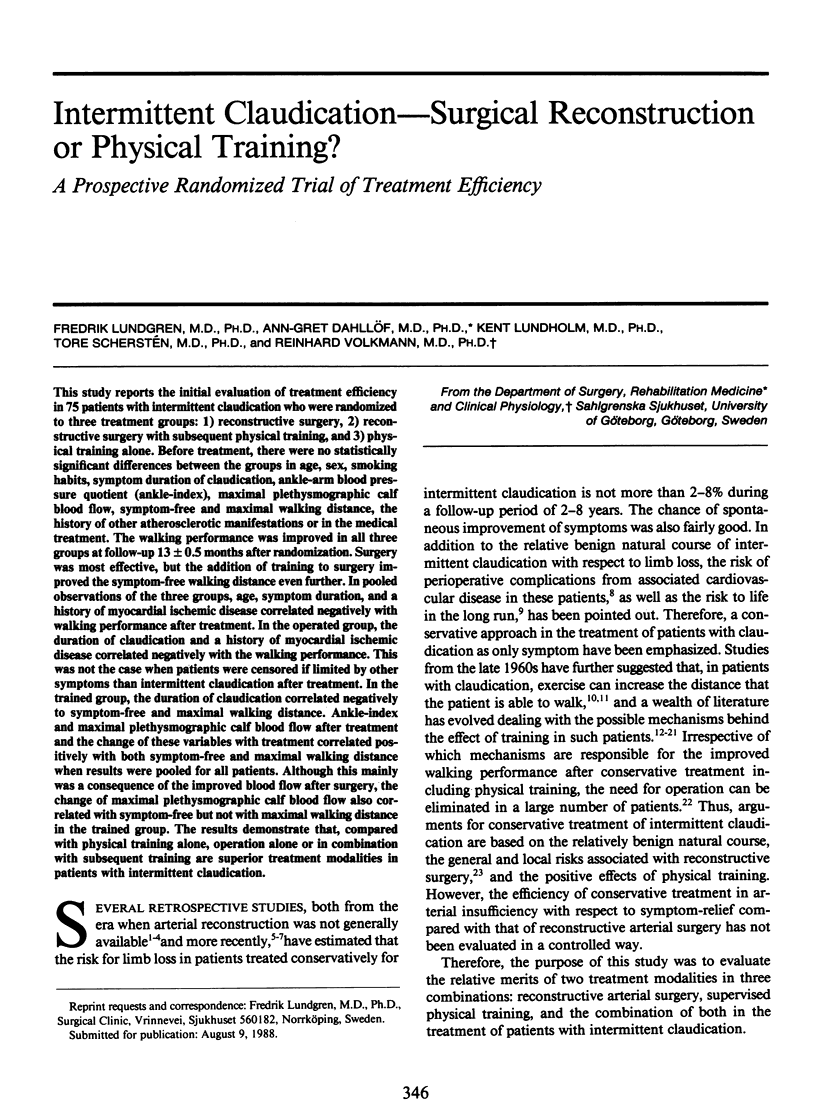
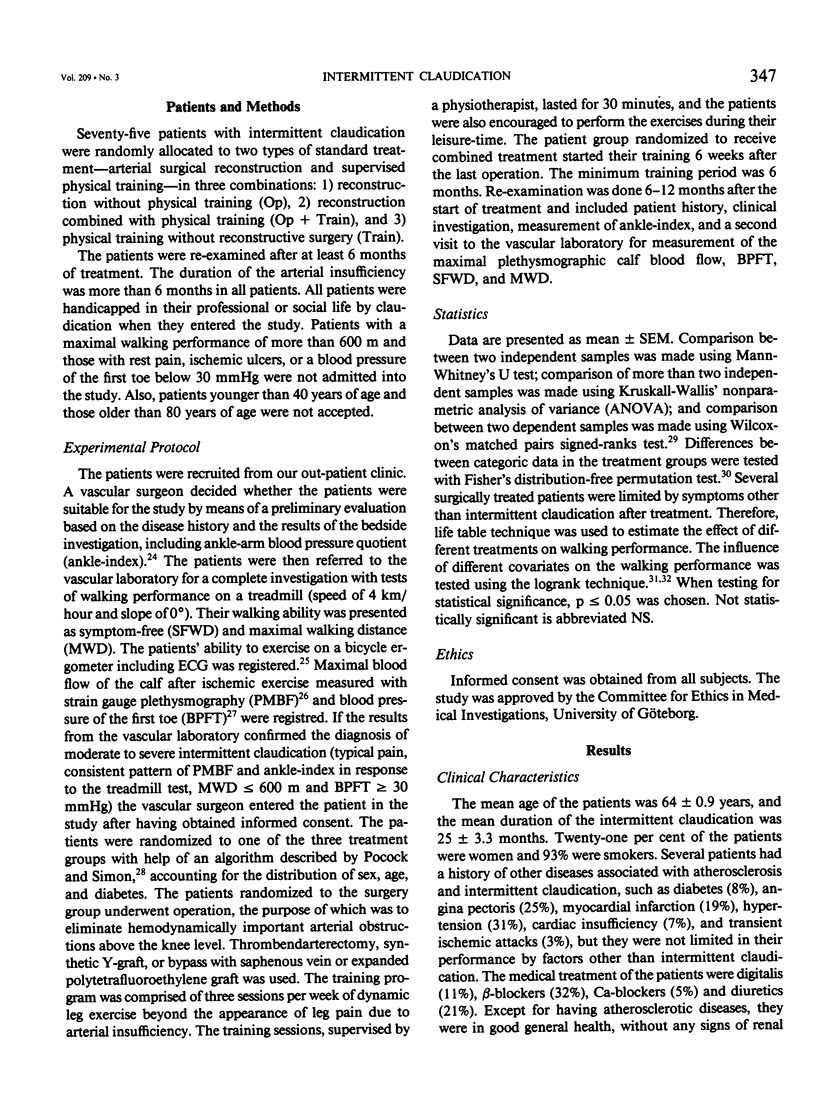
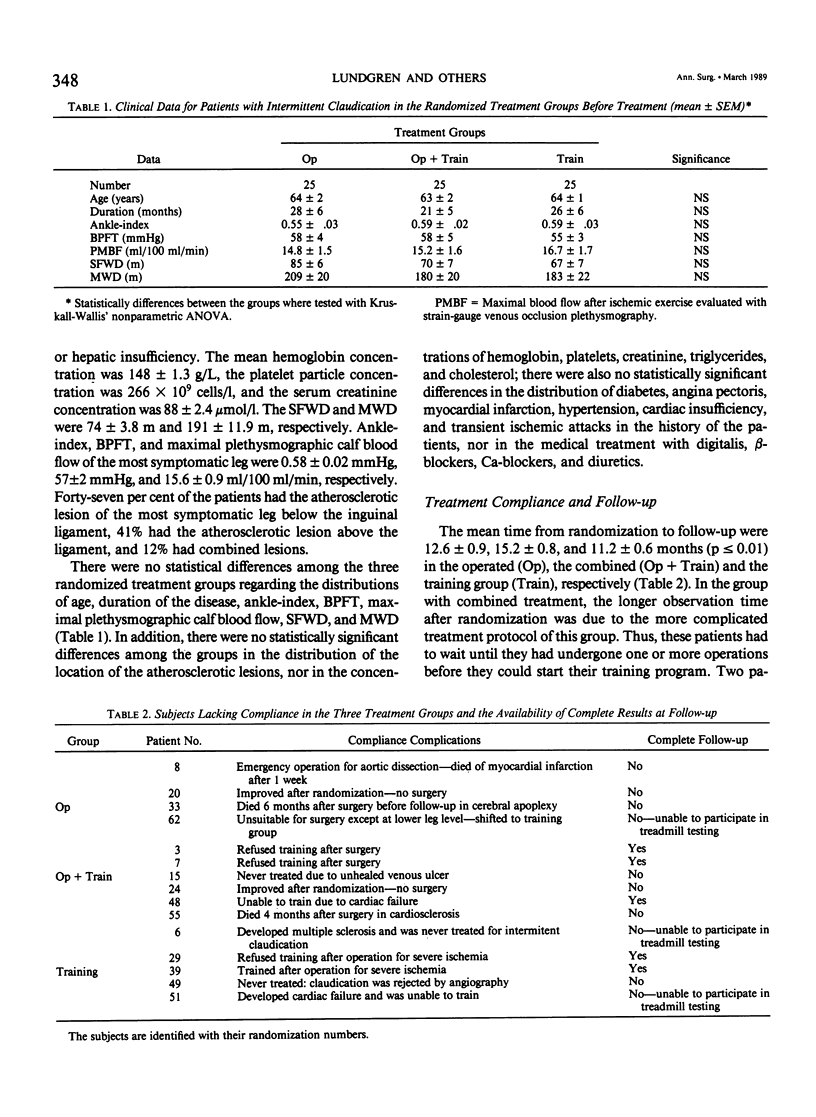

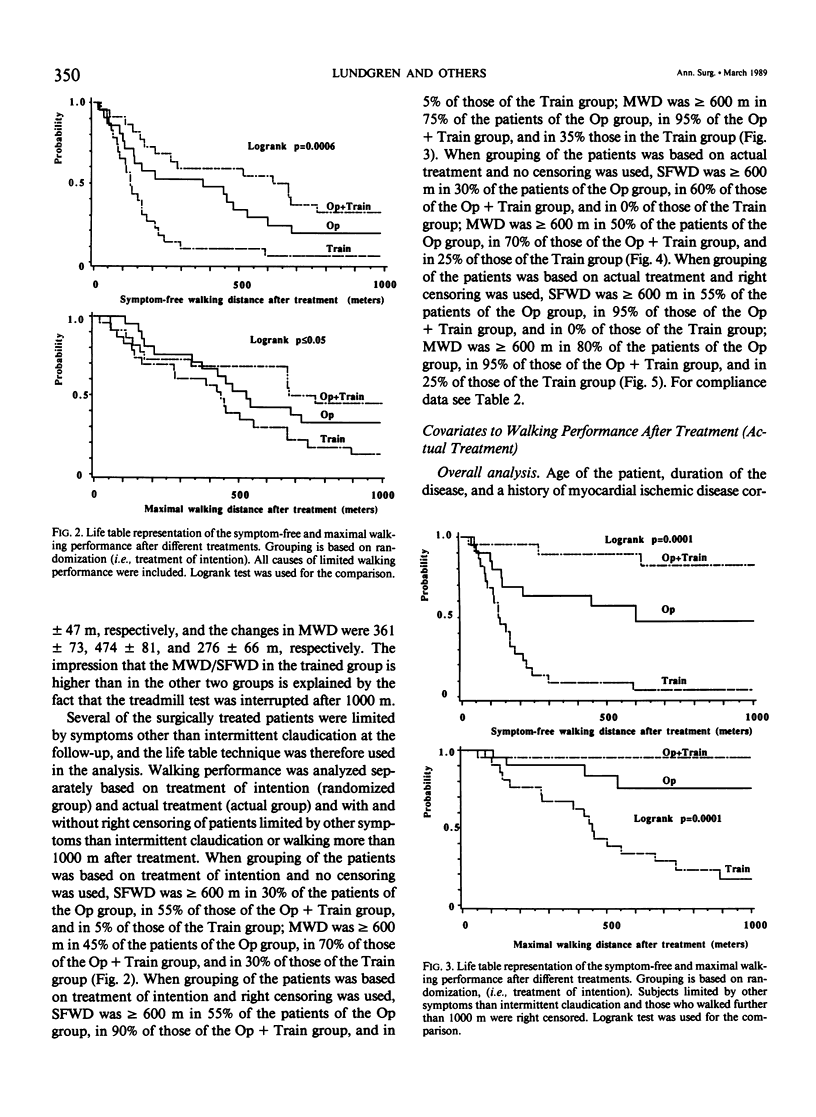
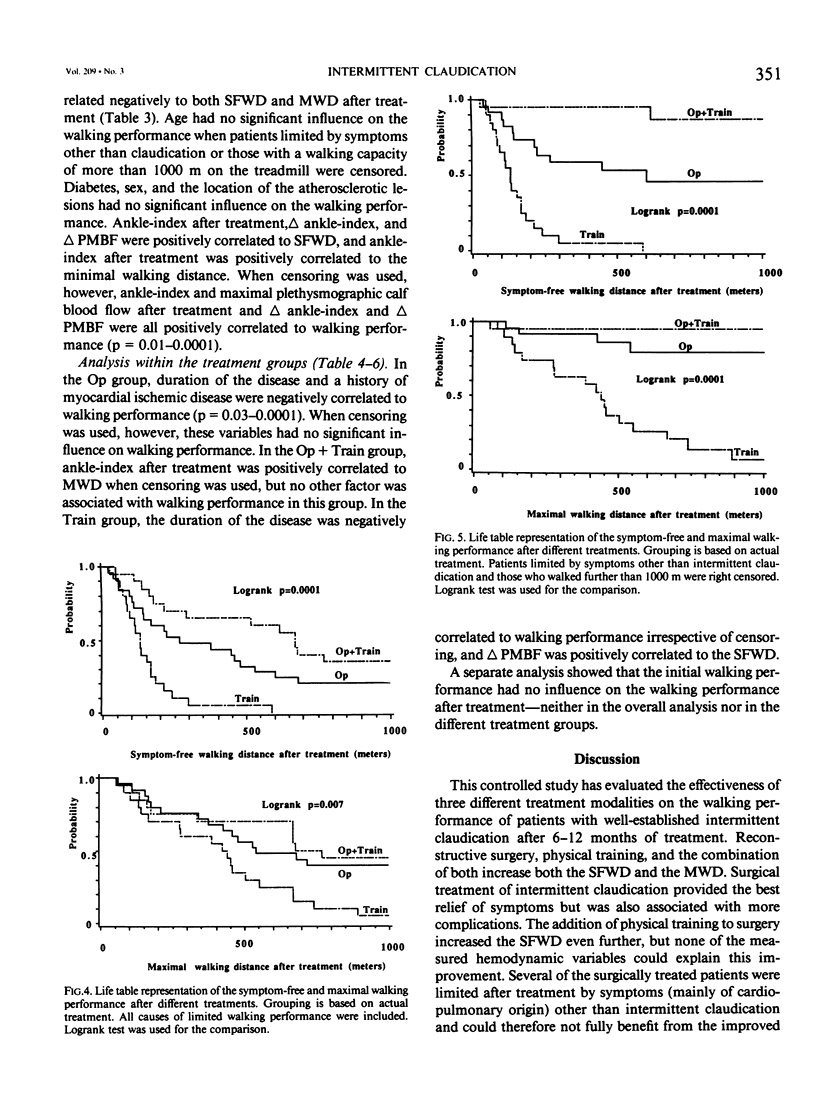

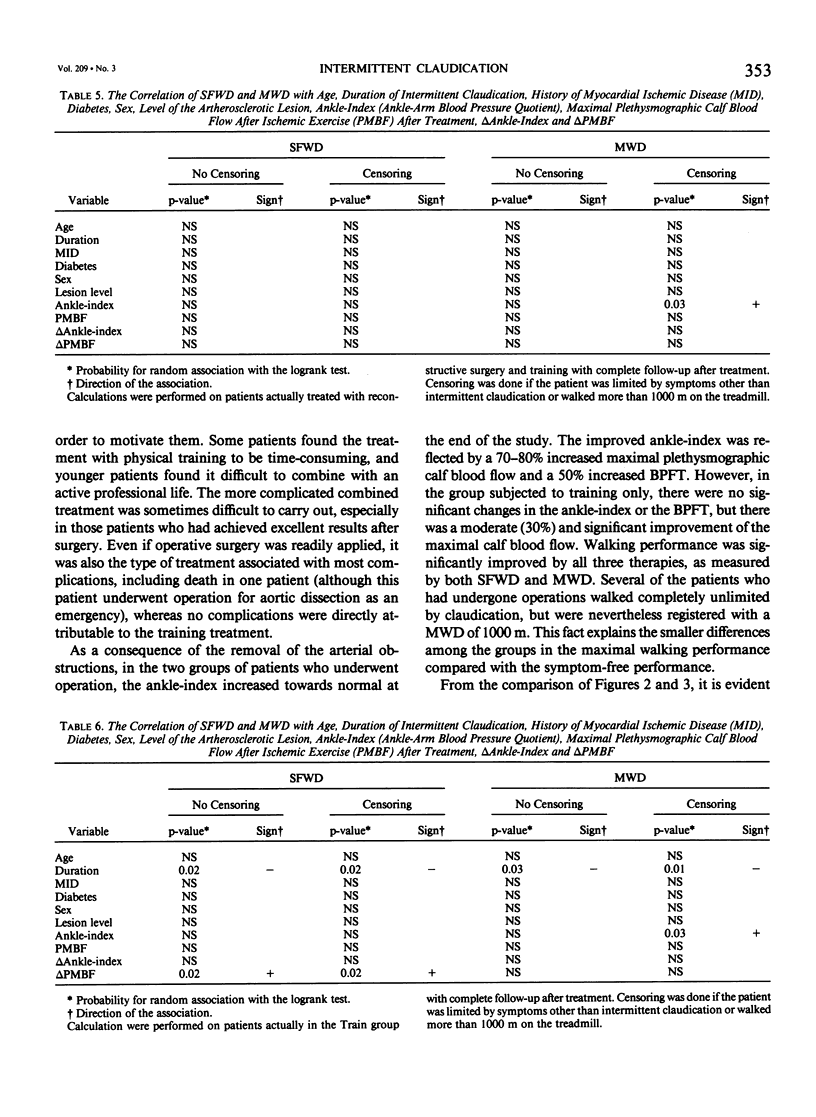
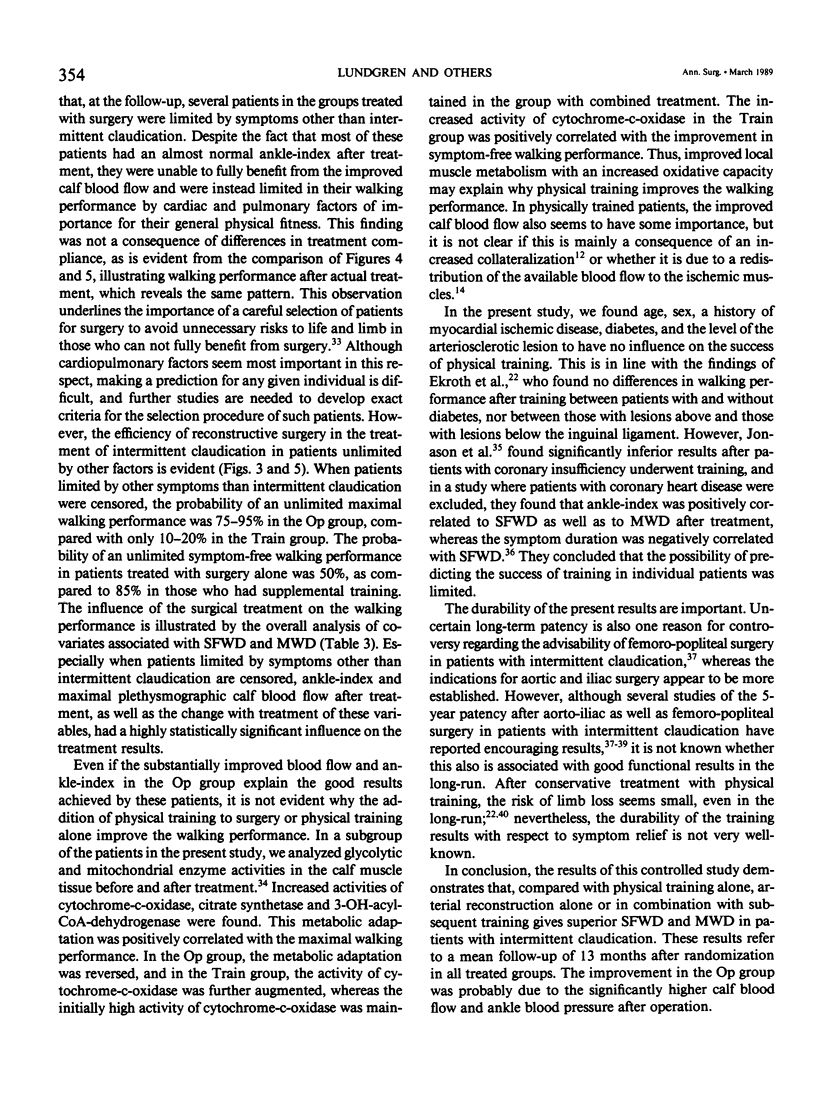
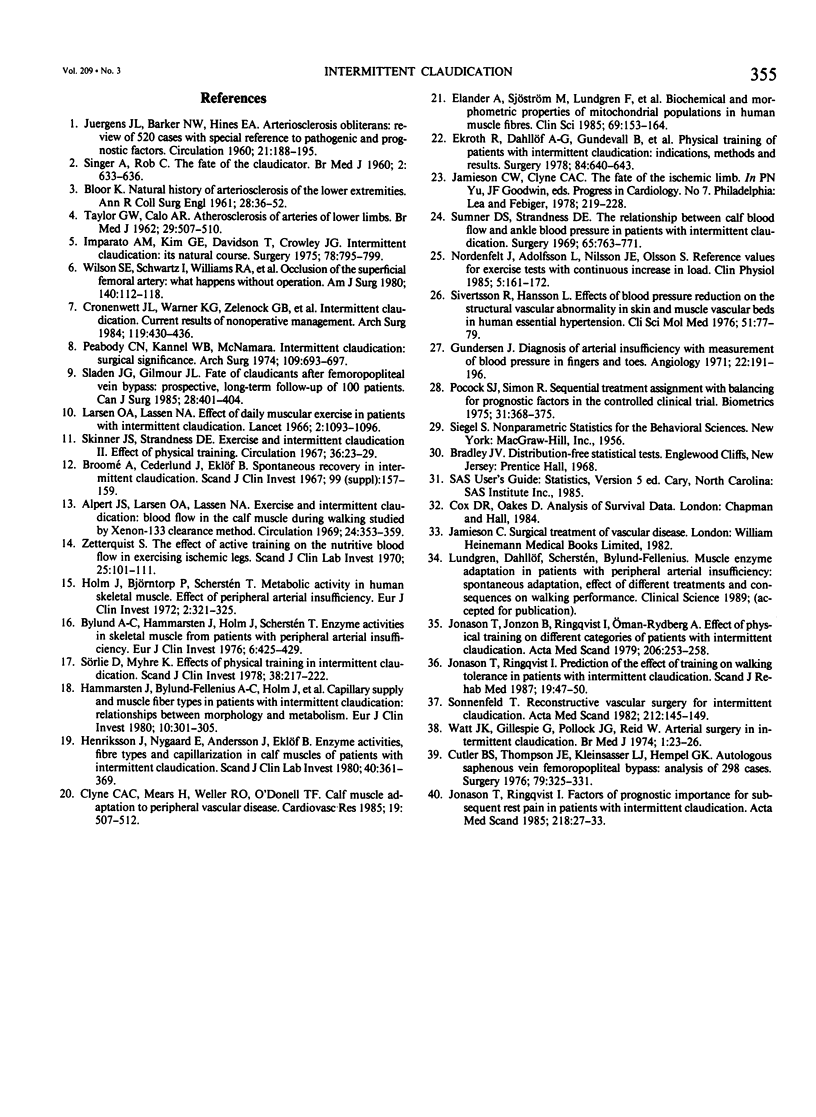
Selected References
These references are in PubMed. This may not be the complete list of references from this article.
- Alpert J. S., Larsen O. A., Lassen N. A. Exercise and intermittent claudication. Blood flow in the calf muscle during walking studied by the xenon-133 clearance method. Circulation. 1969 Mar;39(3):353–359. doi: 10.1161/01.cir.39.3.353. [DOI] [PubMed] [Google Scholar]
- Broomé A., Cederlund J., Eklöf B. Spontaneous recovery in intermittent claudication. Scand J Clin Lab Invest Suppl. 1967;99:157–159. [PubMed] [Google Scholar]
- Bylund A. C., Hammarsten J., Holm J., Scherstén T. Enzyme activities in skeletal muscles from patients with peripheral arterial insufficiency. Eur J Clin Invest. 1976 Nov 30;6(6):425–429. doi: 10.1111/j.1365-2362.1976.tb00538.x. [DOI] [PubMed] [Google Scholar]
- Clyne C. A., Mears H., Weller R. O., O'Donnell T. F. Calf muscle adaptation to peripheral vascular disease. Cardiovasc Res. 1985 Aug;19(8):507–512. doi: 10.1093/cvr/19.8.507. [DOI] [PubMed] [Google Scholar]
- Cronenwett J. L., Warner K. G., Zelenock G. B., Whitehouse W. M., Jr, Graham L. M., Lindenauer M., Stanley J. C. Intermittent claudication. Current results of nonoperative management. Arch Surg. 1984 Apr;119(4):430–436. doi: 10.1001/archsurg.1984.01390160060012. [DOI] [PubMed] [Google Scholar]
- Cutler B. S., Thompson J. E., Kleinsasser L. J., Hempel G. K. Autologus saphenous vein femoropopliteal bypass: analysis of 298 cases. Surgery. 1976 Mar;79(3):325–331. [PubMed] [Google Scholar]
- Ekroth R., Dahllöf A. G., Gundevall B., Holm J., Scherstén T. Physical training of patients with intermittent claudication: indications, methods, and results. Surgery. 1978 Nov;84(5):640–643. [PubMed] [Google Scholar]
- Elander A., Sjöström M., Lundgren F., Scherstén T., Bylund-Fellenius A. C. Biochemical and morphometric properties of mitochondrial populations in human muscle fibres. Clin Sci (Lond) 1985 Aug;69(2):153–164. doi: 10.1042/cs0690153. [DOI] [PubMed] [Google Scholar]
- Gundersen J. Diagnosis of arterial insufficiency with measurement of blood pressure in fingers and toes. Angiology. 1971 Apr;22(4):191–196. doi: 10.1177/000331977102200404. [DOI] [PubMed] [Google Scholar]
- Hammarsten J., Bylund-Fellenius A. C., Holm J., Scherstén T., Krotkiewski M. Capillary supply and muscle fibre types in patients with intermittent claudication: relationships between morphology and metabolism. Eur J Clin Invest. 1980 Aug;10(4):301–305. doi: 10.1111/j.1365-2362.1980.tb00037.x. [DOI] [PubMed] [Google Scholar]
- Henriksson J., Nygaard E., Andersson J., Eklöf B. Enzyme activities, fibre types and capillarization in calf muscles of patients with intermittent claudication. Scand J Clin Lab Invest. 1980 Jun;40(4):361–369. doi: 10.3109/00365518009092656. [DOI] [PubMed] [Google Scholar]
- Holm J., Björntorp P., Scherstén T. Metabolic activity in human skeletal muscle. Effect of peripheral arterial insufficiency. Eur J Clin Invest. 1972 Aug;2(5):321–325. doi: 10.1111/j.1365-2362.1972.tb00657.x. [DOI] [PubMed] [Google Scholar]
- Imparato A. M., Kim G. E., Davidson T., Crowley J. G. Intermittent claudication: its natural course. Surgery. 1975 Dec;78(6):795–799. [PubMed] [Google Scholar]
- JUERGENS J. L., BARKER N. W., HINES E. A., Jr Arteriosclerosis obliterans: review of 520 cases with special reference to pathogenic and prognostic factors. Circulation. 1960 Feb;21:188–195. doi: 10.1161/01.cir.21.2.188. [DOI] [PubMed] [Google Scholar]
- Jonason T., Jonzon B., Ringqvist I., Oman-Rydberg A. Effect of physical training on different categories of patients with intermittent claudication. Acta Med Scand. 1979;206(4):253–258. doi: 10.1111/j.0954-6820.1979.tb13506.x. [DOI] [PubMed] [Google Scholar]
- Jonason T., Ringqvist I. Factors of prognostic importance for subsequent rest pain in patients with intermittent claudication. Acta Med Scand. 1985;218(1):27–33. doi: 10.1111/j.0954-6820.1985.tb08820.x. [DOI] [PubMed] [Google Scholar]
- Jonason T., Ringqvist I. Prediction of the effect of training on the walking tolerance in patients with intermittent claudication. Scand J Rehabil Med. 1987;19(2):47–50. [PubMed] [Google Scholar]
- Larsen O. A., Lassen N. A. Effect of daily muscular exercise in patients with intermittent claudication. Lancet. 1966 Nov 19;2(7473):1093–1096. doi: 10.1016/s0140-6736(66)92191-x. [DOI] [PubMed] [Google Scholar]
- Nordenfelt I., Adolfsson L., Nilsson J. E., Olsson S. Reference values for exercise tests with continuous increase in load. Clin Physiol. 1985 Apr;5(2):161–172. doi: 10.1111/j.1475-097x.1985.tb00592.x. [DOI] [PubMed] [Google Scholar]
- Peabody C. N., Kannel W. B., McNamara P. M. Intermittent claudication. Surgical significance. Arch Surg. 1974 Nov;109(5):693–697. doi: 10.1001/archsurg.1974.01360050087019. [DOI] [PubMed] [Google Scholar]
- SINGER A., ROB C. The fate of the claudicator. Br Med J. 1960 Aug 27;2(5199):633–636. doi: 10.1136/bmj.2.5199.633. [DOI] [PMC free article] [PubMed] [Google Scholar]
- Skinner J. S., Strandness D. E., Jr Exercise and intermittent claudication.II. Effect of physical training. Circulation. 1967 Jul;36(1):23–29. doi: 10.1161/01.cir.36.1.23. [DOI] [PubMed] [Google Scholar]
- Sladen J. G., Gilmour J. L. Fate of claudicants after femoropopliteal vein bypass: prospective, long-term follow-up of 100 patients. Can J Surg. 1985 Sep;28(5):401–404. [PubMed] [Google Scholar]
- Sonnenfeld T. Reconstructive vascular surgery for intermittent claudication. Acta Med Scand. 1982;212(3):145–149. doi: 10.1111/j.0954-6820.1982.tb03187.x. [DOI] [PubMed] [Google Scholar]
- Sumner D. S., Strandness D. E., Jr The relationship between calf blood flow and ankle blood pressure in patients with intermittent claudication. Surgery. 1969 May;65(5):763–771. [PubMed] [Google Scholar]
- Sørlie D., Myhre K. Effects of physical training in intermittent claudication. Scand J Clin Lab Invest. 1978 May;38(3):217–222. [PubMed] [Google Scholar]
- TAYLOR G. W., CALO A. R. Atherosclerosis of arteries of lower limbs. Br Med J. 1962 Feb 24;1(5277):507–510. doi: 10.1136/bmj.1.5277.507. [DOI] [PMC free article] [PubMed] [Google Scholar]
- Watt J. K., Gillespie G., Pollock J. G., Reid W. Arterial surgery in intermittent claudication. Br Med J. 1974 Jan 5;1(5896):23–26. doi: 10.1136/bmj.1.5896.23. [DOI] [PMC free article] [PubMed] [Google Scholar]
- Wilson S. E., Schwartz I., Williams R. A., Owens M. L. Occlusion of the superficial femoral artery: what happens without operation. Am J Surg. 1980 Jul;140(1):112–118. doi: 10.1016/0002-9610(80)90426-2. [DOI] [PubMed] [Google Scholar]
- Zetterquist S. The effect of active training on the nutritive blood flow in exercising ischemic legs. Scand J Clin Lab Invest. 1970 Jan;25(1):101–111. doi: 10.3109/00365517009046196. [DOI] [PubMed] [Google Scholar]


